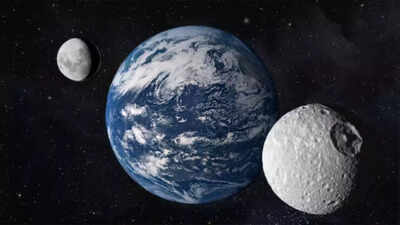ARTICLE AD BOX

It’s not a script for a new sci-fi film, nor is Christopher Nolan behind this ‘conspiracy theory’ – but the Earth seems to have acquired another moon for herself!Yes, in an intriguing twist for space-watchers and astronomy enthusiasts alike, NASA and other researchers have announced that Earth may now be hosting a second moon. Imagine, our well-known moon having a companion… or is it rather a competition?Let’s unpack!
The New Moon
In a discovery that sounds like a sci-fi headline but is very real, astronomers have identified a small near-Earth object, 2025 PN7, which is now classed as a quasi-satellite of Earth.
This means our planet effectively has a second moon — at least until the mid-21st century. NASA has confirmed the object is following a path near Earth and will likely remain connected in this way until about 2083.
What is the ‘new moon’ 2025 PN7?
2025 PN7 is very small — estimates put its size at roughly 18–36 metres across (about the height of a modest building). A year ago, scientists announced that the tiny asteroid 2024 PT5 was captured into orbit around Earth, turning into a mini-moon.
It was first observed in August this year, by the Pan-STARRS survey at Hawai‘i’s Haleakalā Observatory.However, the occurrence of this mini-moon migh not be a new phenomenon. Archival images suggest it may have been travelling with Earth for decades — perhaps since the 1960s. However, unlike the real moon, 2025 PN7 does not orbit Earth directly. Instead, it orbits the Sun in an Earth-like path (a “1:1 resonance”) and appears to follow Earth around the Sun.
This gives us the impression of “two moons” from one point of view.According to scientific calculations, 2025 PN7 is expected to remain in this co-orbiting arrangement until roughly 2083. That gives it a few decades of temporary companionship with our planet. After that, gravitational interactions (with the Sun, Earth and possibly other bodies) will likely move it away from its current path.
A companion or a competition?
Now that the Earth has two moons – does that mean our OG moon has found a new companion? Or is it possible that the status of our OG moon is under threat?Science suggests, while 2025 PN7 poses no threat to Earth (it’s small and its orbit is stable in this context), it is of real scientific interest.How so?2025 PN7 belongs to a rare class of objects called quasi-satellites (or quasi-moons) — bodies that share an orbit with a planet but are not gravitationally bound to it. Because it remains relatively close (on cosmic timescales) to Earth, it offers a potential “laboratory” in space for studying orbital dynamics, near-Earth asteroids and how small bodies behave in the solar system. Moreover, this discovery also reminds us that even our immediate cosmic neighbourhood is still full of surprises — we may think we know the skies above us, but discoveries like this show there is more to find.However, it’s important to note and keep in mind that although we’re calling it the ‘second moon’, the feat is a little more nuanced than just the name. For starters, 2025 PN7 is not a true moon in the lunar sense – it doesn’t orbit Earth in a bound way. Additionally, the term “quasi-moon” might sound grand, but the object is tiny, faint and hard to observe. Its visibility from Earth is restricted to favourable windows. Furthermore, while NASA has confirmed the object and its co-orbiting behaviour, the exact lifetime estimate (until 2083) depends on orbital models and may be refined as more data comes in.As for thee sky-watchers, it is almost certainly not visible with the naked eye (or even typical amateur telescopes), as its brightness, magnitude, and size make it extremely faint to spot.
NASA Artemis moon rocket launch off for at least a few weeks

 8 hours ago
6
8 hours ago
6










 English (US) ·
English (US) ·